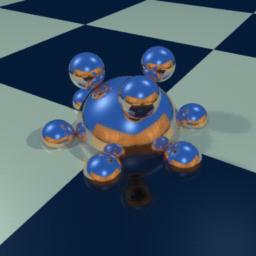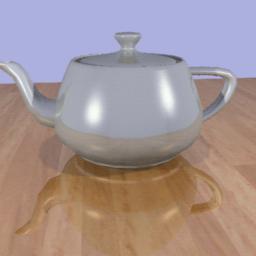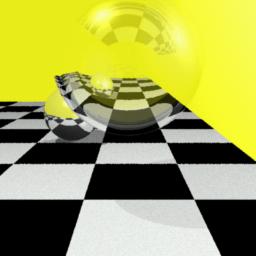





main.cpp - all the
ray tracing code
assn2 - the entire studio
workspace
This ray tracer, as per the assignment,
performs antialiasing and soft shadows (i.e., area
light sources) through jittered supersampling.
As well, it does texture mapping and blurred
reflection. I will describe my implementation and
issues noted for each of these features
in the below.
I made the added functionality ray
tracer on top of a cut and pasted assemblage of
other code. Starting with the parser provided for
our class, I added the assignment 1 ray
tracer to the main cpp file. I then added targa
read and write code also provided our class.
To this, the additional functions were added one at a
time, since they are relatively
independent.
Jittered supersampling and area light sources:
Jittered supersampling allows for area
light sources and antialiased images. First shoot
samples on a finer grid than the final display pixel
size. Jitter them uniformly within the
smaller grid, and keep track of the weighting associated
with that sample, proportional to
the sample's deviation from a gaussian mean centered
at the display pixel center. For
each such ray, when a shadow is cast to an area light
source, jitter the shadow ray in
determining lighting. Once all rays have been computed,
for each display pixel compute
the weighted average of the samples within a reasonable
support of the pixel's gaussian.
Since multiple samples contribute to a pixel's final
color, the jaggies normally found
around edges in the scene look more straight. Also,
the jittering of shadow rays (which
creates uneven, salt-and-pepper shadows) gets evened
out and leaves penumbras, areas
partially in shadow, as seen below.
In the image on the left, aliasing artifacts can be seen along the
teapot's lid and along
shadows in the scene. The image on the right was created with
16 samples per pixel
and downsized with a gaussian filter (standard deviation about .6 pixel).
Notice that
many of the left image's artifacts are blurred away in the right.
Images clockwise. The light creating the shadow in the lower
left of each image is an area light source.
At one sample per pixel, you can see clearly the speckle on the shadow
boundry and also on the
specular highlight of the light source on the balls. The images
then follow with 4 samples, 9 samples,
and 16 samples per pixel. All latter three are filtered with
a gaussian, standard deviation .5 pixel width.
We end up with almost unnoticed speckle in the final image. Notice
the the number of samples per
pixel that should be shot to reduce the speckle is directly proportional
to the thickness of the partially lit
boundary, or penumbra.
I ran into several important things
in implementing these functionalities. First, when
samples over a area are being averaged for final display,
it is vital to energy conservation
to divide the computed weighted average by the sum of
the weights used during the
averaging. Without this, I can get uneven darkness
in the images. Second, the
reasonable support over which to compute this weighted
average I hard code in as three
display pixels. So I am essentially convolving
with a gaussian over nine-pixel areas for
each pixel. I may be losing some of the energy
not counted as the gaussian slips away
to infinity, but that is what dividing by the sum of
weights also solves.
Texture Mapping:
There are only a few things that need
to be done for texture mapping once the
texture file input/output has been figured out (code
that was provided for our class).
First, for ray triangle intersections, I used the algorithm
presented by Brian in class,
from Tomas Möller, which computes the barycentric
coordinates of an intersection.
These coordinates (a third being the sum subtracted from
1) can be used to bilinearly
interpolate between values (colors, normals, etc.) at
the triangle vertices.
For texture mapped triangles, u v
coordinates are provided for each vertex,
referencing places on the image being textured.
For every triangle intersection that I
compute lighting for, simply multiply the material properties
(ambient, diffuse,
specular) by the image color of the triangle at that
spot, and proceed with the lighting.
This added very little additional computation: I bilinearly
interpolate between the vertex
u v coordinates to get the image color at the ray triangle
intersection point. One could
binlinearly interpolate between the image colors surrounding
the image coordinate
needed. I just get the color at (floor(u),floor(v))
and use that, letting the supersampling
take care of blending. This may be better though,
in order to avoid blurring the image
twice (once for interpolation, again during the downsizing
stage).
Blurred Reflection:
Blurred reflection (and refraction)
is jittering the transmited ray in order to obtain a
truer color for a less than perfectly specular surface.
I do this by sampling a gaussian
when determining reflection and transmision rays.
The relfection ray is normalized,
and I look at a gaussian on a plane whose normal is the
ray. I then create a vector by
which to perturb the ray, and renormalize. The
color returned by this ray is weighted
by it's distance on the gaussian plane to the perfect
reflection ray. A hard coded
number of such rays are shot and a weighted average computed.
The perfect relection
ray is always shot, which doesn't bias the final computation
too much if there are
enough rays shot, and it makes the image look less noisy
for large gaussians.

Images clockwise. We start with a slightly reflective texture
mapped surface, with a ball placed on
top. Only the exact reflection vector is computed. Then
a gaussian reflection perturbation of as much
as .5 (or about 14 degrees if at the end of a unit vector), with
11 reflection rays computed. Third is
1.5 perturbation (36 degrees), 11 samples. Fourth is the same,
but with 21 samples. Finally, 2.5
possible perturbation (51 degrees), 40 samples, and 80 samples.
Notice the trend towards more
glossy and less mirrorlike reflection. Compare the last of this series
with the shiny wood floor of the
teapot picture at the top of this page.
There are issues I dealt with for blurred
reflections. With a more in functional
parser implementation, the glossiness (the extent of
the gaussian) would be an object
specific property. I have actually included it
as such, but the parser does not handle
sigma (standard deviation) as a surface property.
Also, blurred reflection
exponentially increases the complexity of a rendering
if the scene is complex enough.
That's why such a simple one level recursion is used
in the above series and not in a
reflective teapot scene like that at the top of this
page.
Conclusions:
Wow, this is cool! With more
time, I would implement contrast driven adaptive
supersampling, depth of field, and texture mapping on
other primitives (prisms and
so on). If I had a few more billion FLOPS, I would
be making movies right now.